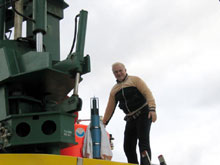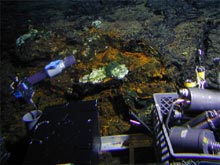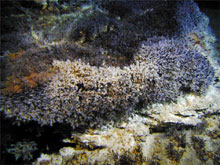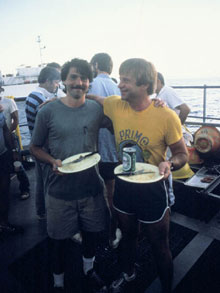
Alex Malahoff (right) and Dan Fornari (left), during the 1980 Galapagos expedition, pictured on Alvin's mothership Lulu. The science party was celebrating the 1000th dive of the Alvin submersible. Click image for larger view
Alex Malahoff exits Pisces V after Dive 623 to Clark Volcano. Click image for larger view.
A Dive to Clark Volcano: Full Circle for a Pioneer
April 30, 2005
Bob Embley
Co-Chief Scientist for the New Zealand American Submarine Ring of
Fire Expedition (Legs 1 and 2)
Geophysicist
NOAA Vents Program, Pacific Marine Environmental Laboratory – Newport,
Oregon
![]() Bacterial mat, small worms, and barnacles were found to be living at diffuse hydrothermal vent sites on Clark volcano. (Quicktime, 1.9 Mb.)
Bacterial mat, small worms, and barnacles were found to be living at diffuse hydrothermal vent sites on Clark volcano. (Quicktime, 1.9 Mb.)
![]() Delicate white chimneys were found at the hydrothermal vents near the summit of Clark volcano. (Quicktime, 1.9 Mb.)
Delicate white chimneys were found at the hydrothermal vents near the summit of Clark volcano. (Quicktime, 1.9 Mb.)
![]() A trip to the bottom inside the PiscesV submersible. (Quicktime, 2.1 Mb.)
A trip to the bottom inside the PiscesV submersible. (Quicktime, 2.1 Mb.)
Alex Malahoff made his first submersible dive almost 35 years
ago. Born in Russia, surviving the awful time of war in his homeland, his
family emigrated to New Zealand in the late 1940s. After graduating from
Victoria University (Wellington, New Zealand) in 1963 he completed his PhD
work at the University of Wisconsin and the University of Hawaii. After
some years as Associate Professor of Oceanography at the University of Hawaii,
he became a program director at the Office of Naval Research for Marine
Geology in the early 1970s. It was here that he took on the role of promoting
the use of submersibles for ocean science. During the 1970s he made dives
with submersibles ranging from the Alvin to the NR1 Navy research
submersible that could stay on the seafloor for weeks at a time. After coming
to NOAA in the late 1970s as the Chief Scientist of the National Ocean Survey,
he organized and led expeditions to the Galapagos Ridge. The discovery of
copper-rich massive sulfides on the Galapagos Ridge in 1980 paved the way
for other research on submarine hydrothermal systems, leading to the creation
of the NOAA Vents Program in 1984. By that time his energies were transferred
back to Hawaii as he took up the position of Professor of Oceanography,
Director for the Hawaii Undersea Research Laboratory (HURL). It wasn't long
before he had acquired the Pisces V submersible and then its mother
ship the R/V Kaimikai-O-Kanaloa (![]() View a trip to the bottom inside the PiscesV submersible.)
In 2002 he returned to New Zealand as the Chief Executive Officer of the
New Zealand Institute of Geological and Nuclear Sciences, one of the Ocean
Exploration Program's two New Zealand partners in this expedition (the other
being the National Institute of Water and Atmospheric Research). For almost
twenty years, Alex has passionately promoted the concept of using the Pisces on the island arcs of
the western Pacific, and finally, in 2005, he is seeing his dream realized.
View a trip to the bottom inside the PiscesV submersible.)
In 2002 he returned to New Zealand as the Chief Executive Officer of the
New Zealand Institute of Geological and Nuclear Sciences, one of the Ocean
Exploration Program's two New Zealand partners in this expedition (the other
being the National Institute of Water and Atmospheric Research). For almost
twenty years, Alex has passionately promoted the concept of using the Pisces on the island arcs of
the western Pacific, and finally, in 2005, he is seeing his dream realized.
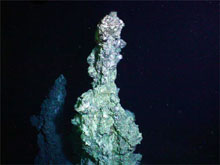
Hot water (221° C, 430° F) was sampled at the base of this sulfide chimney, which is almost 6 meters (19.5 feet) high. Click image for larger view.
Yesterday, Alex, now 66 years of age, dove to the seafloor
at Clark volcano, discovering a whole new world. Clark Volcano is named
after Robert Clark, Professor of Geology at Victoria University (where
Alex studied geology) and the father of Malcolm Clark, marine biologist
and a member of the scientific team on Leg I. The summit of Clark volcano
is covered by lava surfaces encrusted with coatings of hydrothermal manganese
and iron oxide/silica crusts. As Pisces
traversed towards the summit of the volcano it came across signs of diffuse hydrothermal
flow supporting communities of long-necked barnacles and small tube worms (![]() View
the life found living around hydrothermal vent sites on Clark volcano.)
The large beds of mussels seen on the tops of some of the other Kermadec
volcanoes were not found on Clark, although a few small mussels were
recovered along with the barnacles. The highlight of the dive was the
discovery of two large sulfide chimneys dubbed the “Two Towers” by
the dive team. The Two Towers and neighboring chimneys are constructed
of sulfides and sulfates. Hot water was still streaming through the chimney
- samples of 221° C (430° F) fluids were taken at the base of the
largest chimney, which measured almost 6 meters (19.5 feet) high and
several meters across the base.
View
the life found living around hydrothermal vent sites on Clark volcano.)
The large beds of mussels seen on the tops of some of the other Kermadec
volcanoes were not found on Clark, although a few small mussels were
recovered along with the barnacles. The highlight of the dive was the
discovery of two large sulfide chimneys dubbed the “Two Towers” by
the dive team. The Two Towers and neighboring chimneys are constructed
of sulfides and sulfates. Hot water was still streaming through the chimney
- samples of 221° C (430° F) fluids were taken at the base of the
largest chimney, which measured almost 6 meters (19.5 feet) high and
several meters across the base.
After returning from his dive to Clark Volcano, Alex briefed the science party with an enthusiasm undiminished over the decades since he first climbed into a submersible sphere.
Sign up for the Ocean Explorer E-mail Update List.



























